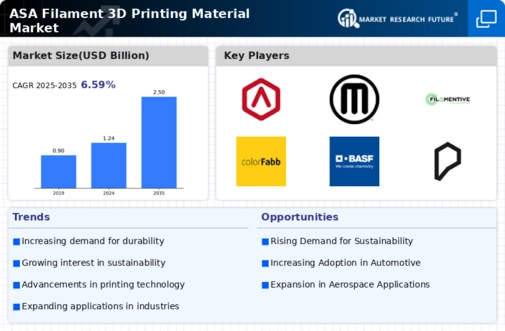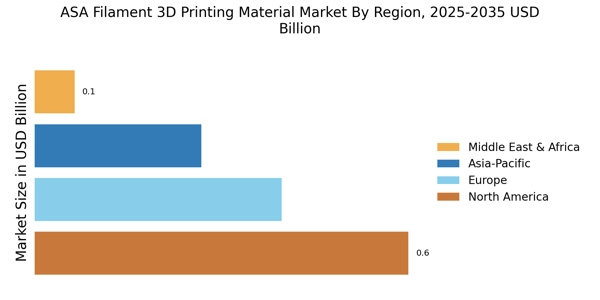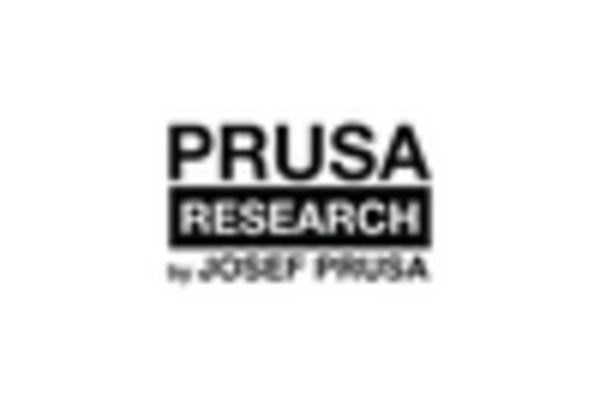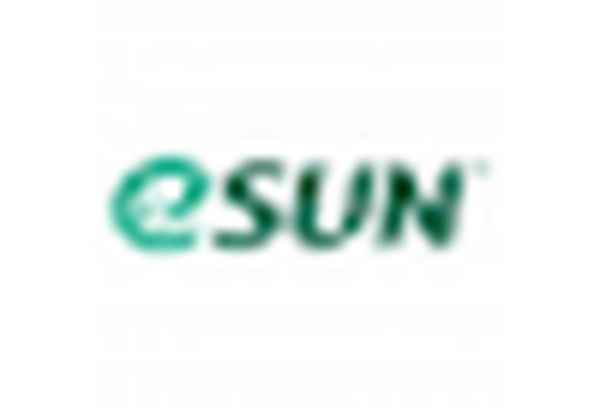Growth in Additive Manufacturing
The ASA Filament 3D Printing Material Market is benefiting from the broader growth of additive manufacturing technologies. As businesses across various sectors adopt 3D printing for prototyping and production, the demand for high-quality filaments like ASA is expected to surge. The additive manufacturing market is projected to reach a valuation of over 40 billion by 2026, with a significant portion attributed to the use of advanced materials such as ASA. This growth is driven by the need for rapid prototyping, reduced material waste, and the ability to create complex geometries that traditional manufacturing methods cannot achieve. Consequently, the increasing integration of ASA filament in diverse applications is likely to enhance its market presence.
Rising Demand for Durable Materials
The ASA Filament 3D Printing Material Market is experiencing a notable increase in demand for durable and weather-resistant materials. ASA filament is recognized for its superior mechanical properties, including high impact resistance and UV stability, making it suitable for outdoor applications. As industries such as automotive and construction seek materials that can withstand harsh environmental conditions, the adoption of ASA filament is likely to rise. Reports indicate that the market for durable 3D printing materials is projected to grow at a compound annual growth rate of approximately 20% over the next five years. This trend suggests that manufacturers are increasingly prioritizing the use of ASA filament to meet the needs of end-users who require longevity and reliability in their products.
Increased Focus on Aesthetic Quality
The ASA Filament 3D Printing Material Market is witnessing a heightened emphasis on aesthetic quality in 3D printed products. ASA filament offers excellent surface finish and color stability, making it a preferred choice for applications where appearance is crucial. Industries such as consumer goods and art are increasingly utilizing ASA for its ability to produce visually appealing prototypes and final products. As consumer preferences shift towards high-quality aesthetics, the demand for ASA filament is expected to grow. Market analysis suggests that the aesthetic quality of 3D printed items can significantly influence purchasing decisions, thereby driving the adoption of ASA filament in various sectors.
Emergence of Eco-Friendly Alternatives
The ASA Filament 3D Printing Material Market is experiencing a shift towards eco-friendly alternatives as sustainability becomes a priority for manufacturers and consumers. ASA filament is often viewed as a more environmentally friendly option compared to traditional plastics, as it can be recycled and has a lower environmental impact during production. This trend aligns with the increasing consumer demand for sustainable products, prompting manufacturers to explore and adopt ASA filament in their 3D printing processes. Market studies indicate that the eco-friendly materials segment is expected to grow significantly, potentially reaching a market size of 10 billion by 2027. This shift towards sustainability is likely to enhance the appeal of ASA filament in various applications.
Expansion of Educational and Research Institutions
The ASA Filament 3D Printing Material Market is also being propelled by the expansion of educational and research institutions that are incorporating 3D printing into their curricula and projects. As educational institutions increasingly adopt 3D printing technologies for teaching purposes, the demand for reliable materials like ASA filament is likely to rise. Research institutions are utilizing ASA for experimental applications due to its favorable properties. This trend indicates a growing recognition of the importance of 3D printing in education and research, which could lead to a sustained increase in the consumption of ASA filament. The integration of ASA filament in academic settings may foster innovation and creativity among students and researchers alike.

















Leave a Comment